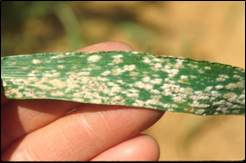Powdery Mildew in Wheat
Powdery Mildew
Symptoms
Powdery mildew can easily be diagnosed by the white, powdery patches that form on the upper surfaces of lower

Powdery mildew
University of KY Dept. Plant Pathology
leaves and stems. The white patches are often said to resemble cotton. With age the patches turn a dull gray-brown and may have small black specks embedded. This disease can spread to all above-ground parts of the plant.
Cause
The fungus responsible for powdery mildew can persist between seasons in infested wheat stubble and in overwintering wheat. Spores then infect plants during periods of high moisture (not necessarily rain) and cool to moderate temperatures. Low light intensity, which accompanies dreary weather, and a dense, lush crop canopy favor this disease. Hot daytime temperatures (80 degrees F plus) and moderate nighttime temperatures will stop powdery mildew development.
IPM Techniques
Plant resistant or moderately resistant varieties. Avoid excessively dense, lush stands by using adequate, but not excessive, planting rates and spring-applied nitrogen.
References and Additional Information
- IPM-4 Kentucky IPM Manual for Small Grains
- PPA-10c Kentucky Plan Disease Management Guide for Small Grains by D.E. Hershman and Paul Vincelli
- Annual Kentucky Small Grain Variety Trials, Progress Report 355
- PPA-36 Fungicides to Control Leaf Diseases in High Yield Wheat
- Foliar Fungicide Use in Wheat, Grain Gleanings, Vol.1, No. 3 (1993)
- Selecting Wheat Varieties, Grain Gleanings, Vol. 1, No. 9 (1993)
- Common Diseases of Small Grain Cereals. F. J. International Maize and Wheat Improvement Center, Londres 40, Apdo. Postal 6-641, Mexico, D.F., Mexico
- Compendium of Wheat Diseases, M.V. Wiese, The American Phytopathological Society Press, 1987.


